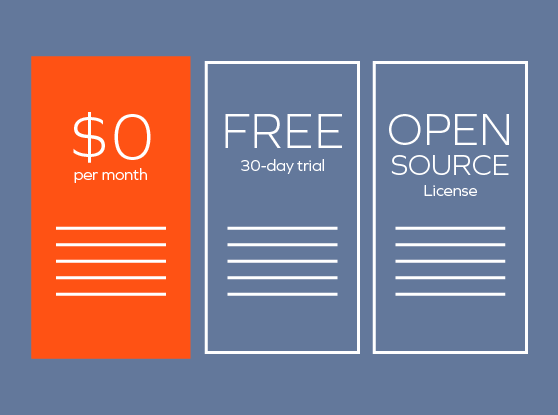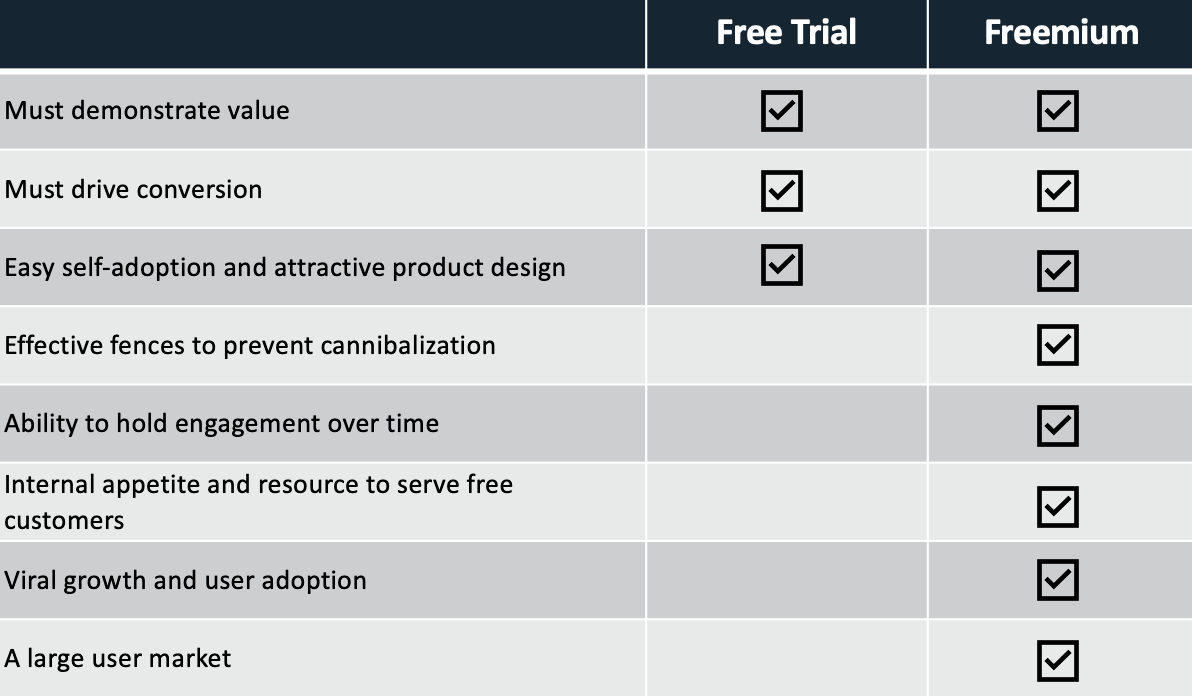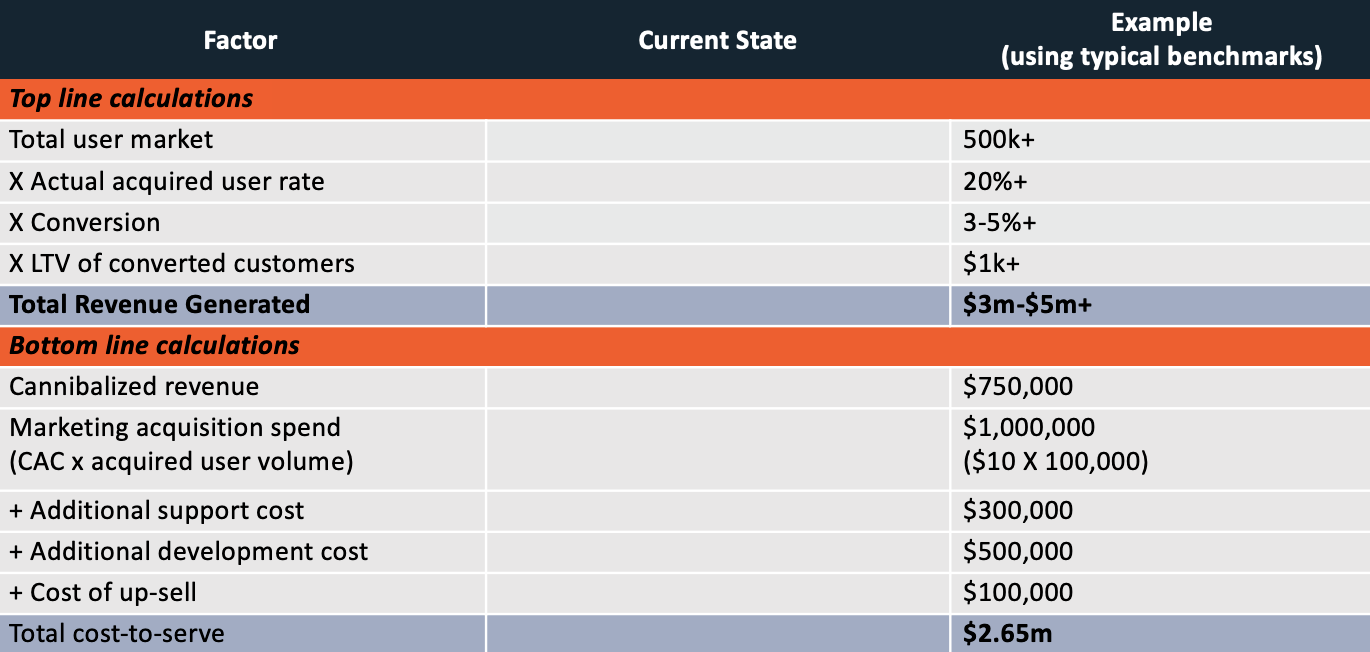How to Build a Winning PLG Revenue Model: Should You Go Freemium?

Product-Led Growth (PLG) is in vogue when it somes to scalably growing software companies. As Insight's pricing specialists we get a lot of questions from our ScaleUp companies about how to do it effectively. Hence this blog series.
One of the most important things to focus on is your overall revenue model and how it allows you to effectively guide customers through each stage of the PLG flywheel.

Our last blog post Product Led Growth: The New Paradigm In Software Selling outlined the importance of thinking about PLG strategically across the whole business. This series provides some thoughts and frameworks to help you create the strategies that will make it a success. In this post, we dive into the first stage of the customer flywheel – getting customers to “find and discover” your product. We’ll focus on the three most common methods of PLG acquisition:
- Freemium is an evergreen free version of your solution that provides a home for users (and companies) who are interested in exploring your product but don’t yet have a willingness to pay for it.
- Free trial is a free version of your paid solution that is available for a limited time to customers so that they can test out capabilities before they buy.
- Open source is software or code developed by you that is available publicly for development and reproduction by a community of users.
Read on for details about how you can decide which one is suitable for you, and how you can optimize the levers within each.
The Freemium/Free Trial Checklist
A freemium or free trial pricing model, which is used instead of or in addition to a time-intensive inbound and outbound sales-development motion, can help achieve three major objectives:
- Scaling your outreach
- Getting a large base of users familiar with your product
- Creating product-qualified leads
- For freemium or free trials to work effectively as an acquisition strategy, there are several prerequisite factors that need to be met. Use the checklist below to evaluate how suitable each strategy is for your business.

Factors critical to both freemium and free trial success
A free trial or freemium offering must provide enough value for customers to understand the benefits of your product, commonly known as the “aha!” moment. A poorly executed trial or freemium offering is more likely to drive potential customers away from your product than drive interest, so do it right the first time by clearly showing enough of the value that the full version has to offer. Once you’ve shown value, you need to maintain it until customers are ready to pay.
For either freemium or a free trial, understanding where and when customers reach the “aha!” moment is key. Use product usage and conversion data to track, test, and optimize where this moment lies in the customer journey. Then design your free plan(s) around it, making sure customers reach it and are compelled to convert through messaging or sales outreach. This might mean extending your free trial or allowing higher usage limits on freemium if the existing design is too restrictive.
It is often harder to demonstrate real value using a limited freemium vs. a full-featured trial. This means that when you’re hiding the full functionality of your product suite from unpaid users, you should demonstrate the added value of the full product by highlighting whatever features they’re missing. You also have a couple of options to improve customer’s ability to realize the value:
- Allow users to trigger a free trial when they need to: By running freemium and a free trial (of the paid product) simultaneously, you can use freemium to nurture customers until they are likely to see the value of the free trial, and customers can opt for full functionality when they start to hit roadblocks in the product.
- “Seed” premium functionality, up to a limit: Allow customers to utilize a limited amount of valuable functionality in the product for free while reserving heavier usage of that feature for paid plans. This allows customers to discover the value of the feature, without giving too much away. For instance, Pagerduty allows free users up to 100 SMS alerts, 1 on-call schedule, and 1 escalation policy to get them interested in the higher-value features.
Must Drive Conversion
The primary goal of most free offerings is to drive revenue in other areas of the business. As such, the effectiveness of your program will be measured by how many free users eventually become paying customers. In B2B software, an optimized free trial program such as Chargebee’s should have ~15% conversion to paying customers. This should rise to ~25% if you ask for a credit card on signup (with a corresponding trade-off in the number of overall signups). They do this by providing the right balance of giving and withholding value to make signing up for the paid product a no-brainer.
Typical freemium conversion rates tend to be a lot lower. The average B2B conversion rate is just 2-5%. You can still find success with even lower conversion rates if the user market is big enough. Think about Dropbox, which only has 175,000 paying customers despite having 500,000,000 users, which translates to a conversion rate of 0.04%. To optimize your conversion, you need to master user adoption, retention, and effective up-sell. Conversion rates are a guide and allow for good benchmarks, but the most important KPI is the absolute number of acquired customers. A 50% conversion from 100 signups is going to be 10x worse than a 5% conversion from 10,000 signups. For freemium, this usually means that viral adoption in a large user market is critical to success.
Easy Self-Adoption and Attractive Product Design
Without an intuitive interface and design, it will be impossible to engage users to the extent needed to effectively make conversions. The best free designs allow users to learn the product and reach the “aha!” moment almost instantly so that they are engaged enough to return and eventually purchase. This is even more important within the scope of a free trial because the user has a limited amount of time to realize value before they are forced to pay. When optimizing the length of your free trial, look to set the time at the minimum amount of time it takes for users to see and understand recurring value from the product, so that they are compelled to convert quickly before losing attention.
Factors especially critical to success in freemium
Ability to Hold Engagement Over Time
An ability to hold engagement is a very important PLG flashpoint – especially for freemium models. Trials only need to hold engagement for 14, 30, or 90 days. Regardless, each model needs to be able to retain user activity until customers get to the point of wanting to convert. If a user churns from a free version, it is unlikely that they will think about purchasing your paid product. There are two types of products that hold engagement for a long period of time:
- Products that constantly change and require frequent attention: Slack, which has user retention of 93%, has perfected this. Its product is frequently being brought to the top of mind with new messages or channel activity driving relevant notifications. Outside of the B2B space, gaming companies such as Epic Games (creators of Fortnite) and consumer tech companies such as Peleton have also mastered the art of a continually evolving experience and also use gamification (levels, badges, etc.) to reward user loyalty.
- Products that are embedded into a process workflow: If a product needs to be used on a continual basis, such as Monday.com for project management, it will maintain its relevance. The goal for these companies is to build as much useful functionality and collaboration into the product as possible, placing the product at the very center of that workflow.
Effective Fences to Prevent Cannibalization (and Drive Up-Sell)
The biggest risk with any freemium product (especially when launching alongside an existing paid product) is that customers who do have the willingness to pay will start using the free option instead. This leads to a direct loss in revenue. There is a tricky balance between providing enough value to be engaging while not enough to incentivize cannibalization.
The best way to get around this is by differentiation. Features that drive users to use the product (e.g., Slack’s gifs) will often not be the features that are needed to scale the product across a large business such as IBM. In this case, things like shared channels, administration features, SSO, and collaboration would have more value. Understanding and using the right features as fences are vital for success.
We would recommend using a design research tool (like UserTesting) to understand how features are used within your product environment and which features are critical to product engagement. In addition, run quantitative and qualitative tests with business decision-makers on what features drive willingness to pay (using conjoint, gabor granger, or other pricing research methodologies). Marrying these pieces of information together should give you an accurate picture of what the best features are to differentiate paid and freemium offerings. Research is key, as well, to test that customers really understand what functionality you are using to fence between tiers at the point at which they’d make a decision. If they are too obscure, or there are so many that it is confusing, it won’t work. These key questions (and many others in PLG) cut across the typical functions of marketing, sales, and product, and ensuring that you have a complete view is important. This is why many PLG companies in our portfolio are turning to cross-functional growth teams to get the right solutions.
Internal Appetite and Resource to Serve Free Customers
Serving a large base of free customers (where only 1 in 20 will end up paying you) can be immensely time-consuming when it comes to serving support tickets and answering questions. In our experience with freemium companies, free users will feel just as entitled to a good product experience as paying ones. Typeform, for instance, spends $130,000 per month just to support its free user base. Some products will be able to operate effectively by providing community support alone, but more technical products will not, and the risk of not providing adequate support is that stuck users will churn.
When understanding whether freemium makes sense, estimate that the support cost will increase relatively linearly from your current support cost per user (excluding dedicated support such as CSMs). Build this added cost-to-serve into your calculations.
To minimize the added lift of freemium on your support team, it is critical to invest in self-service and community-sourced resources before launching. Detailed FAQs, Wikis, technical guides, and community platforms such as a developer Slack channel can help minimize the added lift. Some companies, such as Contentful, channel their entire freemium support flow to self-service and community-supported channels rather than direct to their support team.
Viral Adoption
One commonality among successful freemium offerings is the ability to grow quickly through user evangelism. In this model, word-of-mouth from existing users will do a fantastic job of providing new leads without having to rely on paid advertising or outreach. Of course, the core of this is having a free offering that people want to evangelize. In addition, there are a few tactics you can use to drive further adoption:
- Collaboration features such as chat shared project management, and shared editing can ensure that users within a company will invite their team to join them.
- Context-based invitations such as “join this project” make for a more effective call-to-action for prospective users that receive them.
- Referral bonuses incentivize customers to actively pursue word-of-mouth marketing (Dropbox used this to improve growth rates by 60%).
- Reviews and testimonials help build credibility in the early stages of product growth, in particular, on sites such as G2 or Capterra, as this adds significant SEO benefit.
A Large User Market
The freemium concept relies exclusively on a large market to work. If you convert 1 in 20 users to a paid plan, that means that 19 out of 20 users won’t pay you. In a market such as Slack’s or Dropbox’s, where the user base is almost universal, that is unlikely to be an issue – the benefits of cost-effective growth and increased virality of a freemium product will more than make up for the fact that many users don’t convert. In limited markets (e.g., point solutions that target a team of <5 people per company in a specific industry), the balance swings the other way. In these markets, freemium is more likely to burn high-quality leads than it is to generate new ones and therefore should be avoided.
Is Freemium or Free Trial Right for Your Business?
If you launch a free trial without meeting the prerequisites above, then you are likely to become what Openview has aptly termed a “PLG imposter” – you tick the box of having a free trial but it doesn’t tend to lead to a true PLG motion. Most of these companies will need sales or customer success to assist their motion, and, as such, the free trial might be a distraction for customers or your own resources rather than a big help.
If you launch a freemium without meeting these prerequisites, the outlook might be even worse. You stand the risk of cannibalizing current paid business with something that costs you money to support but provides no revenue now or in the future. If in doubt, a time-limited free-trial strategy is likely to be the best starting point, as it carries significantly less risk to your day-to-day sales and operations.
In most cases, we would recommend adding on a free trial of your paid product when you have freemium. This can help your customer get easier access to paid functionality for a short period of time and strengthen your ability to generate true product-qualified leads without needing to spin up a sales process.
What About Open Source?
Open source can be a valuable play in the developer space, providing brand kudos and a vibrant community that can generate interest and network around your product. It has made the names of many companies famous, including WordPress and Docker. However, it’s not the same thing as a freemium or free trial model. The big distinction between open source and freemium or free trial is that of direct customer connection.
In a freemium or free trial, your customers are actively using a version of your product and getting the full experience in a way that then leads them to potentially convert to paid later on. In open-source, your customers are utilizing your IP in terms of functionality but with little to no link to your core product. As such, the path to conversion is less direct.
Open source is not a replacement for freemium or a trial in your core product, and even if you pursue open-source, we would recommend seeing whether a freemium or free trial of your paid product is right for you. Open source will rarely cannibalize significant amounts of revenue when it comes to real use cases for your main product. Customers will likely experience operational pain when it comes to fully implementing and maintaining the open-source version.
Looking at the Insight portfolio of over 100 PLG companies, open-source is by far the least utilized of the three. Only 5% of our PLG companies have a clear open-source option on their website compared to 46% offering freemium and 57% offering a free trial. This shows that it tends to be adopted by a more niche set of developer-focused companies that can truly take advantage of the community benefit and brand impact.

Preparing for Freemium: Playing the Numbers Game
If the checklist above suggests that a freemium model would work for your business, we would recommend developing a business model to double-check the financial sensibility of pursuing it. For a free trial, the risks are lower, and it is possible to do this in less detail. At the very minimum, this model should be financially positive in the most conservative scenario. It is critical to pay close attention to, and be honest about, the potential downsides. In our experience, these can be easily overlooked, but in many cases, both the costs associated with freemium and the potentially cannibalized existing revenue can add to a significant sum. Ensure you have a strong opinion on each of these revenue and cost factors before adopting a freemium model.

Conclusion: Always Think Strategically!
For us, the biggest mistakes we’ve seen made in PLG happen when a company dives in when it’s not right for their business or adopts a PLG strategy before their product and market are truly ready to support it. At all stages of developing your PLG strategy, you should plan on how it weaves into the core of your go-to-market strategy, rather than bolting on to the side. These decisions should be made cross-functionally, and your operations, product, and go-to-market teams should be ready for the challenge that implementing PLG will bring.
When it comes to freemium, especially, look before you leap. The risk of adopting a free tier is a big one in terms of potential revenue cannibalization and costly support burden. Once launched, there’s no easy emergency exit.
Use the checklist above to help your teams make smart decisions on optimizing your revenue model for a PLG world. If you have any questions, our Onsite team members have experience working with hundreds of PLG companies, and you can ask us anything at PLG@insightpartners.com.











